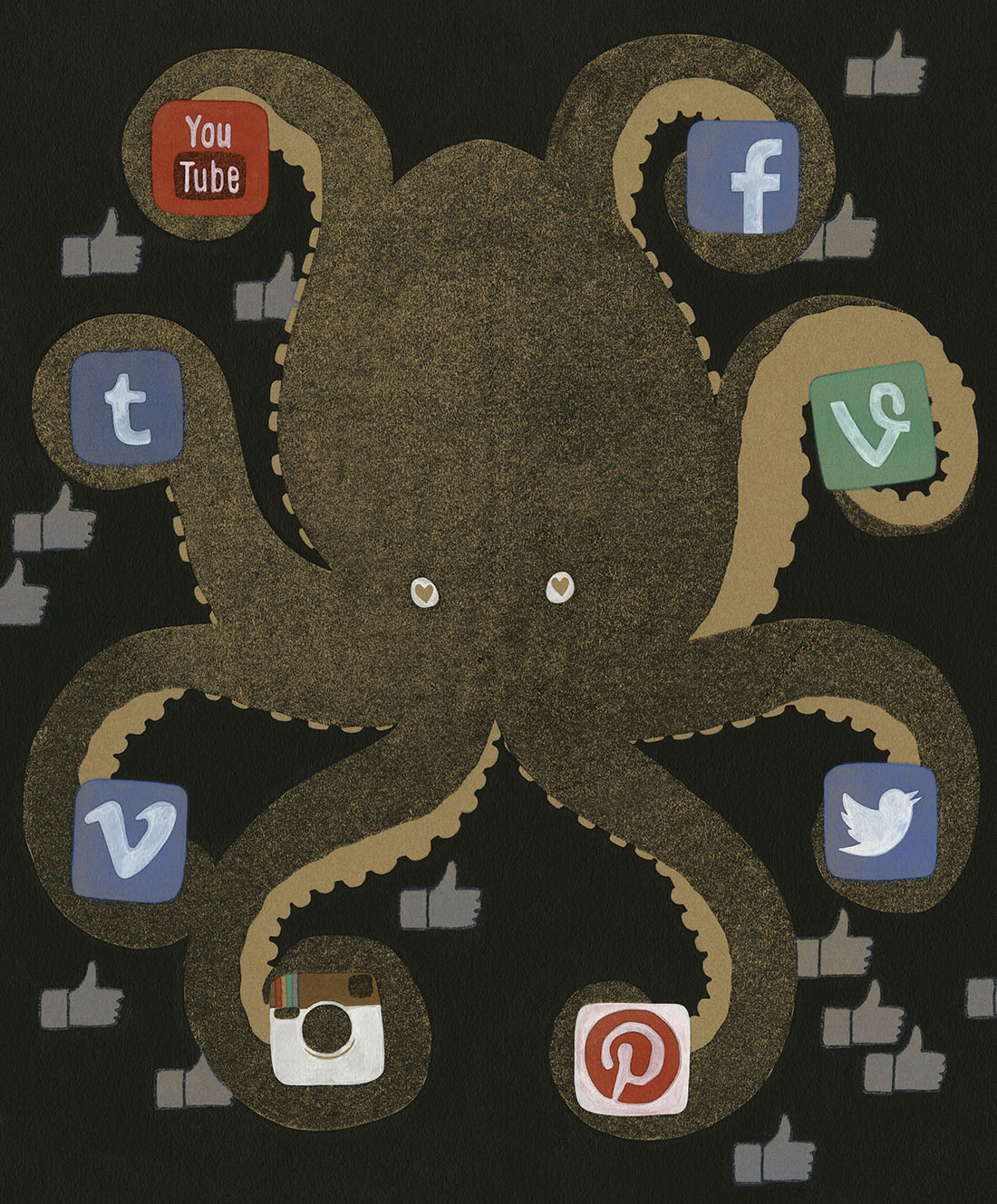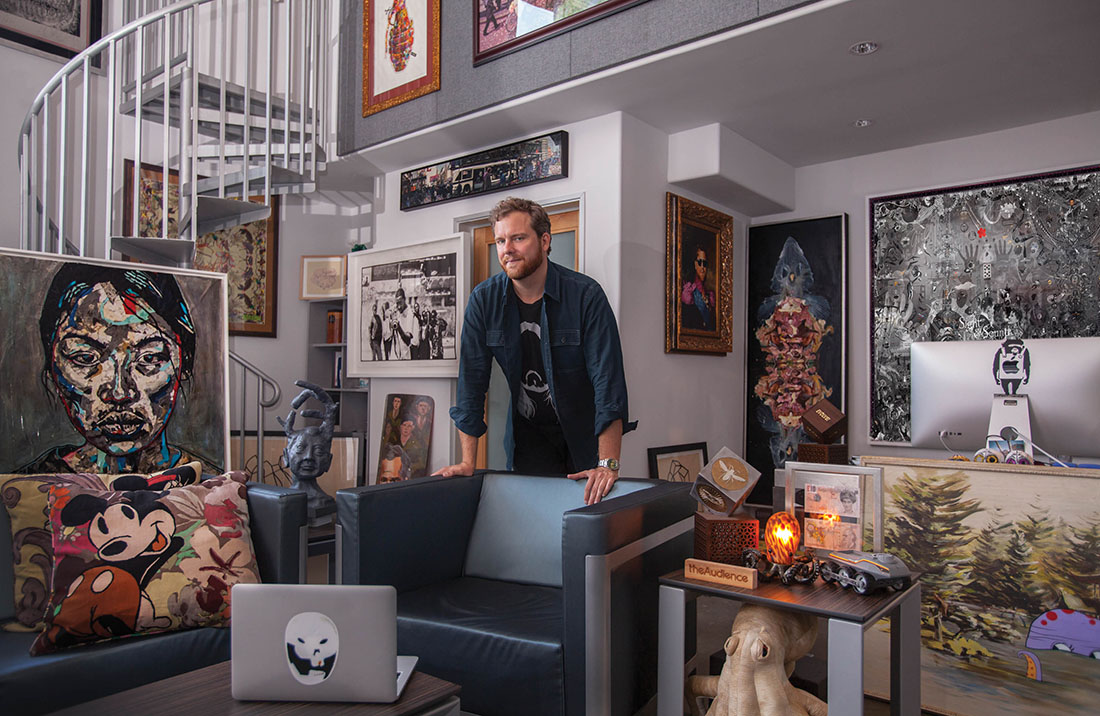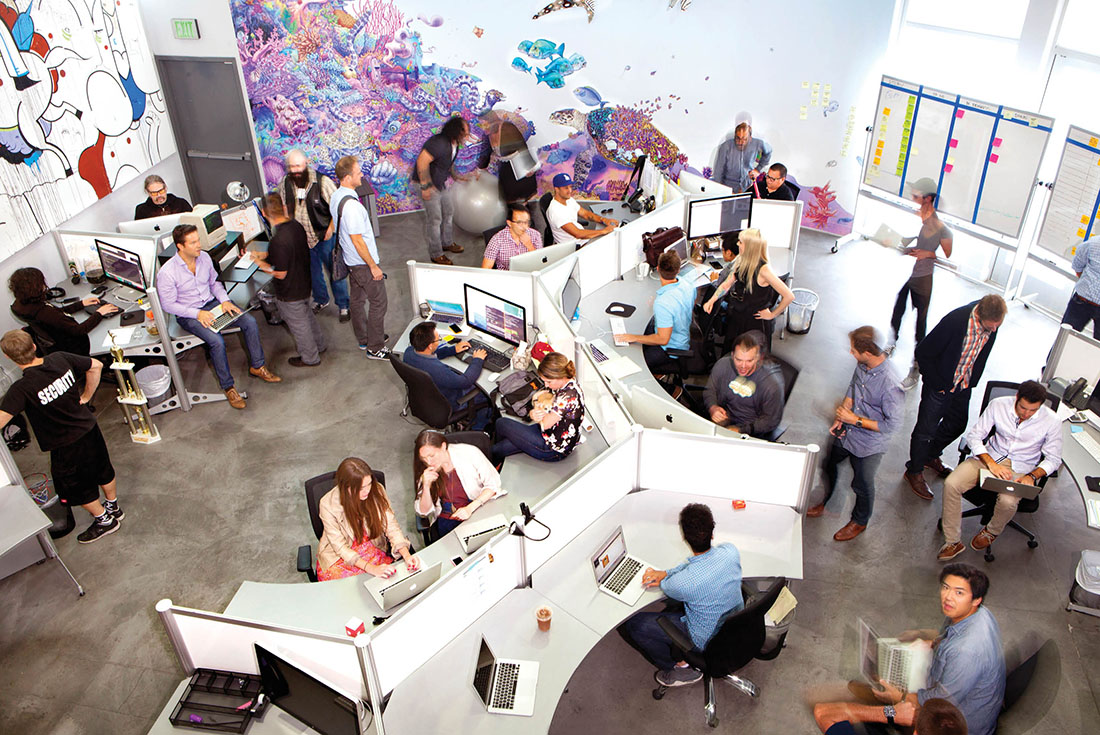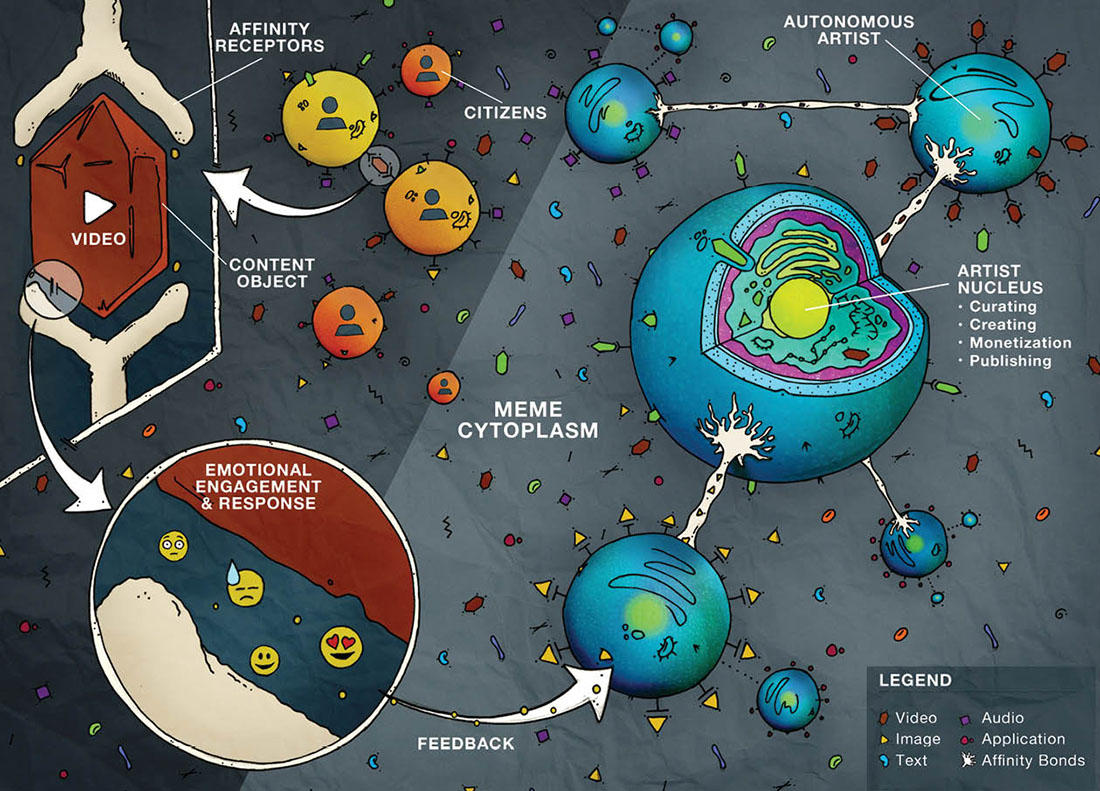
(ILLUSTRATION BY EDWARD KINSELLA III)
Oliver Luckett, BA’96, never saw it coming. When he stepped off the curb to cross the busy San Francisco street, the taxi cab was moving much too fast for him to react. And in the blink of an eye, his life was never the same.
It was 1996, just days after his graduation from Vanderbilt, and Luckett was excited to be embarking on a new adventure on the West Coast. He didn’t have a job lined up, or really any solid prospects for that matter, but given his lifelong love of computers, he knew he’d landed in the right place. He was near the heart of technological innovation in Silicon Valley, after all, and the Internet boom was just getting started.
But in that moment on the street, unbeknownst to Luckett, a frightening reality was hurtling straight toward him, and his promising future was in danger of being dashed. That is, until a stranger’s hand pulled him to the safety of the sidewalk at the last second. It would prove to be a fortuitous turn of events in more ways than one.
“This woman grabbed me and screamed, ‘What are you doing?!’ And I said, ‘I’m just a dumb kid from Mississippi,’” Luckett explains, still in disbelief all these years later. “It turns out the woman, Anne Pazarin, had spent her childhood in my hometown of Clarksdale, Mississippi, and owned a tech consulting firm in San Francisco. She ended up giving me my first job in the industry.
“It was totally serendipitous.”
That fateful day in San Francisco is perhaps the only time in Luckett’s life that he got ahead by literally taking a step back. A tireless entrepreneur, he has made a career of diving headfirst into challenges, launching a string of tech startups all intent on shaking up the status quo in one way or another. His latest one, theAudience, is the world’s largest social media publishing company. Based in Los Angeles, it produces thousands of unique pieces of content on behalf of its clients each year.
In 1996, though, social platforms like Facebook and Twitter were still years from becoming reality, and Luckett’s dreams of starting his own company were distant at best. Back in Pazarin’s office, he was simply a 22-year-old kid looking to get his foot in the door somewhere.
“She asked me what hourly rate I would want. I said, ‘I don’t know. I think I made $8 at Chili’s during college. She thought for a moment and then said, ‘How about $78?’
“Well,” he laughs, “that sounded a lot better to me.”

DIGITAL IMMIGRANTS AND NATIVES
Of the 1.5 billion people around the globe who use social media regularly, most are familiar with content published by theAudience. They just don’t realize it. That’s because the content comes from many different voices across multiple social platforms.
In one instance, it might be a celebrity who posts a message on Facebook, or maybe a well-known corporate brand sending out a tweet. In another, it might be someone less recognizable (at least to those over the age of 25), but no less capable of reaching millions of millennials—perhaps a “selfie queen” posing for her followers on Instagram, or an up-and-coming band uploading their latest music video to YouTube.
Whatever the message, theAudience is the go-to company for crafting it and overseeing its distribution. “We’re a little bit like the man behind the curtain,” said Luckett, the company’s CEO, in an interview with Mashable in 2013.
If anything, this anonymity has been a crucial ingredient in theAudience’s success. When Luckett started the company in 2011 with talent agent Ari Emanuel and tech entrepreneur Sean Parker, they made a point of avoiding publicity. “We didn’t talk about theAudience for nearly two years,” says Luckett, “because anytime we’d give an interview, three other companies would pop up and say they were just like us.”
“Whether he’s talking about his company’s growth from 10 to about 150 employees in three years, or his voluminous social circle of Hollywood power-player friends, or his fluorescent sneaker collection, or his insatiable appetite for street art, illustration and design—a collection that fills additional office space down the street, the London offices of theAudience, and his Hollywood Hills home—less is not more in Luckett’s world. More is … barely enough.” —Los Angeles Times, May 2014
The idea for theAudience may have begun with a simple enough plan—to capitalize on the untapped direct-to-consumer potential of celebrities—but it took a forward-looking vision and a network of powerful connections to set the wheels in motion.
“It started when Ari sent me a list of 440 celebrities he represents,” Luckett says. “I ran an algorithm looking at Facebook and found 110,000 fake pages for those 440 people. Those pages were already connected to 1.2 billion Facebook users, but none of the pages was being operated by those celebrities.”
At the time, Luckett was a senior vice president at The Walt Disney Co. in Burbank, California. In 2008, Disney had purchased DigiSynd, a digital media startup he’d co-founded a year earlier, and turned it into its consumer-facing brand on social media. That deal put Luckett in charge of expanding Disney’s social presence through its popular line of animated characters.
“I’m proud of my time at Disney,” he says. “I got to make fundamental changes to how they do their copyright and their content, and the way they interact with their consumers.”
Before the DigiSynd deal Luckett already had an impressive tech résumé. In the late ’90s, for example, he’d helped develop the first voice-over-IP network in the U.S. at Qwest Communications, which effectively introduced flat-rate pricing to the phone industry. And in 2005 he’d co-founded Revver, the first video-sharing website to monetize user-generated content through advertising—years ahead of YouTube’s similar Partner Program.
As Luckett’s reputation grew within the tech world, he met Parker, a like-minded entrepreneur best known for being the co-founder of the file-sharing service Napster, as well as Facebook’s first president. Parker, in turn, introduced Luckett to Emanuel, co-CEO of talent agency William Morris Endeavor.
“When Ari and I first met, we realized there was enormous potential for these artists,” Luckett says, explaining that Emanuel was seeking expertise in helping his clientele take ownership of their online personas. “You can’t reach millennials if you’re not on any of the social platforms. How will they know that you’re there? They ain’t watching TV, that’s for sure.”
Soon thereafter Luckett left Disney to launch theAudience and began managing social media accounts for A-list actors like Hugh Jackman, Mark Wahlberg and Charlize Theron, as well as best-selling recording artists like Usher. Even President Barack Obama relied on theAudience to handle his main Facebook page during the 2012 campaign.
It didn’t take long, though, for Luckett to realize the limits of working strictly with famous personalities. “Celebrities often come with baggage, and creating their online personas is a lot of work,” he says. “They may be good on TV or the big screen, but most are not digital natives. Like Sean says, they’re ‘digital immigrants.’”
Out of this realization came the next stage of theAudience’s evolution. Luckett turned to “influencers”—everyday people who already have a robust social media presence—and began pairing them with ad campaigns for particular brands. For instance, he brokered a deal for teenager Acacia Brinley, who boasts more than 1.6 million followers on Instagram, to endorse McDonald’s during the 2014 Winter Olympics. Other brands, like Ford Motor Co., American Express and Dove, have used this approach as well.
What Luckett appreciates about Brinley and other so-called “microcelebrities” like her—aside from the fact that they offer more distribution power than many traditional media outlets—is that they express themselves in creative ways that resonate with their audiences.
“I work with more than 6,000 different artists—‘information artists’ is how I think of them,” he says. “Some people don’t view them as artists, but I do. For instance, take Acacia, who has mastered the selfie. Anyone like her who has an idea and puts a frame around it is an artist to me, regardless of the field they’re in.
“Ultimately, it’s how you express yourself. It’s about the way you look at things and how you build an abstract layer on top of what you see.”

ENEMY OF THE STATUS QUO
When Luckett was just 6 years old, his grandfather John Booth Farese presented him with a choice of gifts. He could pick either a three-wheeler—something most boys his age would likely give their right arms for—or a somewhat primitive (at least by today’s standards) Tandy TRS-80 computer. Not surprisingly, Luckett opted for the latter.
“I chose the computer, of course,” he says. “That was in 1980. I’ve now had a computer for 34 years. That’s scary to think about.”
The TRS-80 and its eventual replacements helped unlock Luckett’s innate talent for technology. At first he taught himself how to use a coupling modem to access dial-up bulletin boards (precursors of today’s chat rooms) in different cities across the country. In the process he ran up a whopping $600 phone bill.
“After my parents found out, that lasted all of one month,” he laughs.
Not long after, though, he was learning to navigate the burgeoning Internet before most people even knew what it was. It was during these teenage years, when he was coming to terms with being gay, that technology became an invaluable escape hatch for him. His computer allowed him to see beyond the confines of small-town life to the wider world waiting on the other side.
In time, Luckett found his way out of the Mississippi Delta, but for all the distance he has put between himself and Clarksdale, he still talks fondly about his upbringing and the hometown that made him who he is. In particular he credits his parents, Bill Luckett and Kay Farese Turner, for cultivating his intellectual curiosity and encouraging his interest in the arts.
Bill, the current mayor of Clarksdale, is both a lawyer and an entrepreneur, and has helped reinvent the town through cultural tourism promoting blues music. Kay, meanwhile, is a high-profile divorce attorney in Memphis, Tennessee, who also happens to be a sculptor. She instilled a passion for art collecting in Luckett, and he’s now one of the leading patrons of the arts in Los Angeles.
Luckett, however, is more than just a patron or a collector. He’s arguably an artist in his own right. Like his team of influencers at theAudience, he frames ideas in unexpected ways, offering his own abstract perspectives on the social networks that shape our modern lives.
“I deal in ideas,” he explains. “I try to make concepts into mass reality, whether they’re political or societal or entertainment concepts. And as we become more interconnected, I view the world more and more like a social organism. If you think about it, we’re all connected via a network that has no time or distance. In biological terms, it’s pretty much like a cell, and the artists are the ones who create the genetic variance.”
(See the sidebar below to learn more about Luckett’s ideas regarding the social organism.)
As it turns out, this novel way of looking at social media owes a lot to his Vanderbilt experience. Luckett started out studying molecular biology in college and was planning to enter medical school after graduation. But after two years of working in a lab, he was burned out and decided to switch his major to French literature.
While neither major seems a likely path to becoming a tech entrepreneur, Luckett would argue differently. “I’ve learned so much from molecular biology but also from studying Renaissance literature,” he says. “Vanderbilt had such an amazing French lit department. What really stuck with me was learning about the major changes in society that occurred after the invention of the printing press.
“It has a lot of bearing on what I do today. Just as French literature emerged after the printing press, social media emerged after the invention of the Internet.”
In many ways Luckett embodies this era’s historic upheaval. At Disney he was referred to (affectionately) as “the insurgent” by CEO Bob Iger, and Luckett still embraces that nickname—and mentality—in the work he does today. Quite simply, he has made an art out of challenging conventional thinking.
“Change is inevitable, and I figure I might as well be part of the acceleration of that change versus the other way around,” he says. “There’s no worse fate than the status quo.”
For that reason Luckett isn’t content to let theAudience stand still for long. He and his employees are now embarking on what he considers the company’s third stage. “The next step is really getting behind the content,” he explains, referencing a recent viral video that theAudience produced for The Chainsmokers’ song “#SELFIE.”
“We don’t want to just service people. We want to own the pieces of content. That’s really been my goal: to be able to create a media company out of this and use that direct connection we have.”
Whatever the future holds for theAudience or any other venture he undertakes, it’s safe to say that Luckett will continue riding the waves of technological change. And if the past is any indication, he’ll probably make a few waves of his own in the process.
“Look, a switch has been flipped, and we’re just now beginning to reverberate from it,” he says. “We’re a microsecond into this year of change that’s happening to our society. That excites me.
“I don’t care what happens to the big industries that can’t keep up. They’ve had their time. I say let’s create new ones.”
Seven Rules That Drive Social Media Success

“Facebook architecturally looks very similar to living organisms,” Luckett says. “So, I started thinking that if this looks like life, then maybe it acts like life, too. Maybe these social networks are actual living organisms.”
Drawing upon his Vanderbilt background in molecular biology, he developed a list of seven rules that define all living organisms, including the biggest of them all—what he calls the “social organism.” The more closely one abides by these rules in social media, says Luckett, the more successfully one can connect with audiences.
1. Life must be nourished. “The social organism is nourished by our lives—by the images we take, by the music we consume, by the ideas we share.”
2. Life reacts to stimuli. “Emotions are what trigger the movement inside the organism. Everything that works in the social organism is sharing some emotion, whether it’s fear or love or anticipation or excitement.”
3. Life exchanges with its environment. “Living organisms react to their environment. Every day the sun sets, and thousands of images are uploaded, expressing the emotions people feel about that sunset.”
4. Life rids itself of pollution. “One of the most important things about life is that it gets rid of waste. In this analogy, bad marketing is really the excrement of the social organism. Nobody wants to be spammed.”
5. All life has the ability to flow and move internally. “An organism’s evolution is based on flow dynamics. If I’m a company that blocks content from being available, then I’m actually thwarting the ability for change. You must allow content to flow.”
6. Life evolves through reproduction. “If you look at genetics, the very script of our lives is a meme. The word ‘meme’ means that our ideas replicate through sharing, but they evolve when you add your voice to those ideas.”
7. Living things become larger and more complicated as they grow. “The social organism is changing every day. We’re seeing the rise of people who are native to these environments, and they’re taking advantage of the newness of these systems.”
The seven rules are adapted from a presentation given by Luckett at the 2014 Festival of Media in Los Angeles.